"Ours is a world of nuclear giants and ethical infants. We know more about war that we know about peace, more about killing that we know about living." -Omar N. Bradley
There are some words that, seemingly, you can't utter without inflaming people's passions in one way or another, and nuclear seems to fall squarely in that category. This week, we touched on a number of remarkable topics over on Starts With A Bang, including:
- The biggest spiral galaxy (for Ask Ethan),
- Norway vs. Kenya (for our Weekend Diversion),
- An all-season cluster, M35 (for Messier Monday),
- The chameleon in the vacuum chamber (from Sabine Hossenfelder),
- The bittersweet taste of Philae's limited success, and
- Seeing through our galaxy (for Throwback Thursday).
There's been plenty of comments surrounding these, but no issue raised more out of you, my readers, than the subject of what Philae could have accomplished had it had a nuclear source of fuel on board. Without further ado, let's dive in to your Comments of the Week!
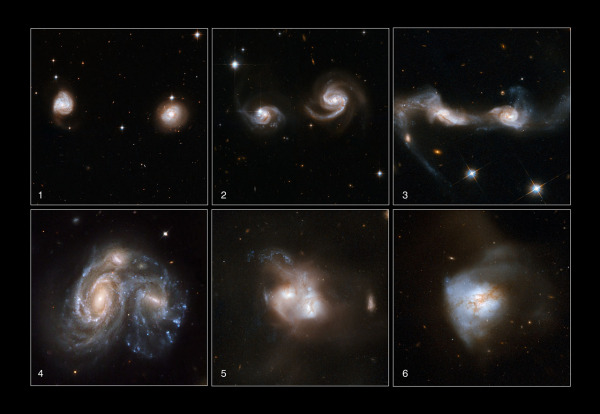 Image credit: NASA, ESA, the Hubble Heritage Team (STScI/AURA)-ESA/Hubble Collaboration and A. Evans (University of Virginia, Charlottesville/NRAO/Stony Brook University), K. Noll (STScI), and J. Westphal (Caltech).
Image credit: NASA, ESA, the Hubble Heritage Team (STScI/AURA)-ESA/Hubble Collaboration and A. Evans (University of Virginia, Charlottesville/NRAO/Stony Brook University), K. Noll (STScI), and J. Westphal (Caltech).
From Doug Watts on galaxy evolution: "I like the subject of galactic evolution because it helps reduce the number of null hypotheses on the evolution of the Universe itself. The evidence shows a clear evolution from spiral —> elliptical. The opposite process never happens: elliptical —> spiral. Or larger galaxy —–> smaller fragment galaxies. Galactic evolution appears to be purely combinatory: galaxies combine and get bigger over time but never split apart and separate and fragment."
The best you'll get if you want to form smaller galaxies from large ones is what happens when two large galaxies merge, and one of them gets very tidally distended due to the merger. Take a look at the image below, and note in particular the "clump" all the way on the left hand side.
Sometimes, gas (and stars) can be stripped from one of the large galaxies, leading to a gravitationally unbound new, small galaxy, or possibly even a series of them. This is possible when you have a system of masses that merges together: the majority of the system becomes more tightly bound, but lower-mass components can be ejected completely, part of a physical process known as violent relaxation.
But by and large, if you're a spiral, the best you can hope for is to remain a spiral, but major mergers can transform you into an elliptical. If you're already an elliptical, there's no going back!
 Image credit: screenshot from the original flash video at http://www.weebls-stuff.com/songs/kenya/.
Image credit: screenshot from the original flash video at http://www.weebls-stuff.com/songs/kenya/.
From our Norwegian reader Gunnar, setting the record straight on Norway vs. Kenya: "There are infinitely more lions and tigers in Norway than 0; both species are represented in the country’s main zoo in Kristiansand.
And Norway’s main export is not tree, but oil and gas from the North sea. I am aware that this does not help the argument, because oil and gas < Tree."
I'll tell you, though, Norway has something that Kenya very much doesn't: a major city located at a high enough latitude so that it has days where the Sun never rises. In fact, Tromsø, Norway, is the largest major city located within either the Arctic or Antarctic Circles, and is home to the original Auroral Observatory.
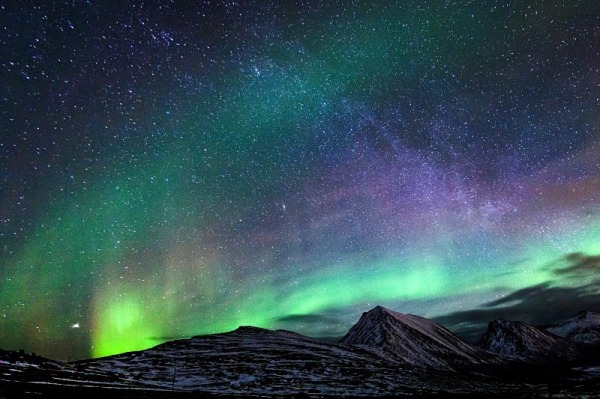 Image credit: © Wayne Pinkston, via http://www.lightcrafter.com/aurora-near-tromso-norway-4.
Image credit: © Wayne Pinkston, via http://www.lightcrafter.com/aurora-near-tromso-norway-4.
In fact, if -- at or near the winter solstice -- someone in or around Tromsø decided to point their camera towards the north star (Polaris) in the sky and leave their shutter open for a full 24 hours, and the skies cooperated to be cloud-free, they could achieve the first-ever true photograph of a 360-degree star trail.
Let's see Kenya do that!
From Peter Krahulik on the subject of "chameleon" dark energy: "Why can’t be Higgs field the chameleon field? You admit they are similar and Prof. Strassler says that it has non zero energy. Do we know (or expect) how it behaves in the areas without particles?"
It is fun to consider what the Higgs field can and cannot be responsible for, in theory. As a quantum field that permeates all of space, it is conceivable that it is tied to either inflation, dark energy or both of them. Of course, that means you have to modify the Higgs to be completely non-standard, but so long as you're also consistent with what we observe and you make new predictions that are testable, that's kind of what theoretical physics is all about. But can the Higgs be a chameleon field?
 Image credit: an unidentified engineer of https://laplacian.wordpress.com/2010/05/16/the-higgs-particle-for-semi-….
Image credit: an unidentified engineer of https://laplacian.wordpress.com/2010/05/16/the-higgs-particle-for-semi-….
No; the chameleon field has different properties altogether, and any particle arising from it would have a variable mass, something inconsistent with what we see in the Higgs boson. However, the chameleon field could couple to the Higgs, which would give interesting -- and potentially observable -- consequences for the Higgs boson. We are still working to understand "the areas without particles," and it is impossible to isolate the quantum vacuum from the Higgs field. So no, we don't know how it behaves, at least, not yet.
From PJ on seeing through our Universe: "Well, that was totally mind-blowing. IR conversion coming up for the ‘scope ! !"
Although this is normally the place you'd expect something snarky about how we should be going to space to view the infrared Universe, it's actually quite reasonable to build yourself an infrared telescope right here on the ground! While the atmosphere isn't completely transparent to IR light the way it is to visible light, there are a few small "windows" in the atmosphere that allow certain wavelengths of infrared light through, with the largest peaking right around wavelengths of 10 microns.
 Image credit: NASA / CoolCosmos / JPL-Caltech, via http://coolcosmos.ipac.caltech.edu/cosmic_classroom/ir_tutorial/irwindo….
Image credit: NASA / CoolCosmos / JPL-Caltech, via http://coolcosmos.ipac.caltech.edu/cosmic_classroom/ir_tutorial/irwindo….
However, there are a number of things to consider if you're building a telescope on the ground to view the Universe, but the two biggest are high sky transparency (or how easy it is to see through the atmosphere; no wavelengths are 100% transparent to IR radiation) and low sky brightness (or how much light is emitted by the atmosphere itself). Unless you're a professional observatory at incredibly high elevations, I'd really recommend, if you're considering doing IR astronomy yourself, focusing on one of four very narrow windows between about 1.1-1.4, 1.5-1.8, 2.0-2.4, or 3.5-4.0 microns in wavelength. Here's why.
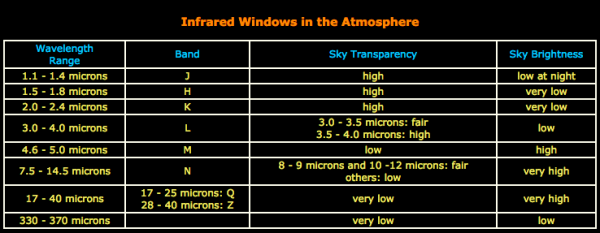 Image credit: NASA / CoolCosmos / JPL-Caltech, via http://coolcosmos.ipac.caltech.edu/cosmic_classroom/ir_tutorial/irwindo….
Image credit: NASA / CoolCosmos / JPL-Caltech, via http://coolcosmos.ipac.caltech.edu/cosmic_classroom/ir_tutorial/irwindo….
You want to see through the atmosphere, and be able to focus on extraterrestrial sources, not sources coming from our own planet. Although you will get atmospheric effects no matter what you do, those are the ways to minimize your pollution from terrestrial effects, and maximize the amount of Universe you yourself can observe. This is what Paolo Maffei did half a century ago to open up the IR Universe, and you can do the same thing today! (And if you do, send photos!)
And finally, here's just a selection of what you had to say about Philae's bittersweet and limited success, that could have been so much more if we had used a nuclear fuel source.
From eric: "So I’m not sure we can really blame the lack of a thermonuclear power source on American irrationality regarding TMI and other accidents. Maybe it was a PR decision, or maybe it was a science/engineering decision that we don’t have all the details about."
From singe: "I’ve been upset for a while now about our dwindling supply of Plutonium-238. Can’t we get somebody on this? Elon Musk maybe?"
From Derek Lyons (excerpted): "...because of their weight and expense, RTG’s are a dang poor choice for a mission that’s likely to be over in a few months when the comet approaches perihelion and starts to outgas."
From Tim Allman: "You have given no rational for the chosen design. You make a good case for the use of Pu-238 but I suspect that this was considered by the ESA and rejected. Why?"
And from Omega Centauri: "If the greatest need is to get the electronics warm, RTGs start sounding better, i.e. you want the “waste” heat. In fact I could easily imagine a hybrid system, a small RTG used to keep critical components warm, and PV to produce electricity."
Very briefly, there is a treaty -- ITAR -- that pretty much prevents all potentially weaponizable nuclear material from being transported across country lines. Plutonium-238 (which very much exists) is non-weaponizable, but only exists in abundance because of remnants from the cold war: it was a by-product of producing nuclear warheads. It's also a wonderful nuclear isotope for space missions, because it has a number of practical properties:
- Pu-238 exists as a dioxide, where it can be compressed into spheres/pellets that are virtually indestructible, and won't get into the atmosphere.
- Because it's an alpha-emitter and insoluble in water, it poses no danger to humans either in proximity or if ingested. Only if inhaled can it be harmful: if it settles in the lungs.
- The odds that a rocket explosion containing Pu-238 would cause even one additional death are far below 1% even in the worst case scenario.
- And finally, we did have a mission failure containing a payload with Pu-238 (Apollo 13). The Pu-238 was simply contained and resides at the bottom of the Tonga trench. No, James Cameron did not retrieve it.
Why wouldn't ESA use it? Well, this is the first outer Solar System mission not to use it, and they actually say why in their FAQ for Rosetta:
All previous deep space probes have used RTGs [Radio-isotope Thermoelectric Generator]. Why did ESA choose not to use them for Rosetta?
ESA has not developed RTG (i.e. nuclear) technology, so the agency decided to develop solar cells that could fill the same function.
Because they haven't developed it, they wouldn't partner with NASA on using RTG technology, and they didn't want to violate ITAR, as far as I can tell. Let me tell you my perception of what an American would have done in Europe's situation. And by "an American," I want you to get the right picture in your head.
Do you think an American would say, "Oooh, we better not do that, it might violate ITAR." Or do you think an American would be far more likely to say something like this:
Yeah, I'm pretty much just going to do this, because it needs to get done and this is the best way to do this.
Oh, you think it violates ITAR? Nah, I'm pretty sure it doesn't. Pretty sure there's no violation. I'm just going to do it this way.
What, I can get sued? What are you going to sue me for. I told you, it doesn't violate ITAR.
Oh, you're suing me? Good luck with that. I've already bought my damned Plutonium from the Russians for this space mission.
Oh, that's a lawsuit? I couldn't hear you over the sound of me launching my awesome Plutonium-powered space mission into space to do the science that you wouldn't do yourselves.
Oh, we're having the lawsuit go forward and you're going to find me guilty? Who cares, I'm already on a comet with all the power I need.
I realize that this "attitude" difference between Americans and Europeans is one of the biggest cultural differences between both societies, but I really don't understand the European perspective here. I mean, it's been explained to me, but I don't understand it in the same way I don't understand refusing to punch the bully in his face because you're afraid he'll kick your ass. Sometimes, you just have to stand up for yourself, and do what you know is both the right thing and the smart thing to do. You can't live your life in fear of the bully.
Now, there really is a problem of having a Pu-238 shortage, and we're probably going to run out within about a decade if we don't actually decide creating more is worth it from a scientific perspective, as it should be on every mission that needs it.
There are other myths out there about Pu-238 and RTGs in general. Here's one: the weight-to-power ratio. Philae's panels/battery delivered 32 Watts from 27 lbs. Curiosity's Pu-238 delivers 120W from 94 lbs., for comparison. See also Sinisa Lazarek's claim that:
– Philea’s power source weighs 12.2kg and generates 32W electrical at 3AU
– for that output we can look i.e. SNAP 19 RTG (powered Pioneer 10&11).. generates 40W electrical and weigh’s 13.3 kg (of that less than 1kg is in Pu238)
So, there's that. There's also the myth Philae did all the science it needed to.
Did it drill down into the comet? Did it discover why there's at least a layer of hard ice? Did it watch the comet offgas from on the surface and learn how it behaves and loses mass?
Let me tell you, conservatively, you could have used two grams of Pu-238 for heat only, and solar panels for the rest. That would've been enough to keep the electronics warm, similar to what the Spirit and Opportunity rovers did. The only reason not to is fear. Was it a NIMBY fear? Or a fear of US retaliation? Or a fear of a bunch of strange protesters?
 Image credit: AFP, via http://www.telegraph.co.uk/news/worldnews/europe/france/10007604/France….
Image credit: AFP, via http://www.telegraph.co.uk/news/worldnews/europe/france/10007604/France….
Demand the best science, demand the tools to do it, and quit it with the settling for inferior anything for non-scientific reasons. It's your Universe, too; don't you deserve to learn all that we can about it?

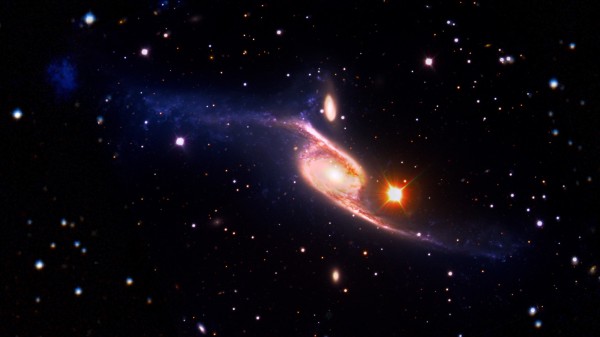
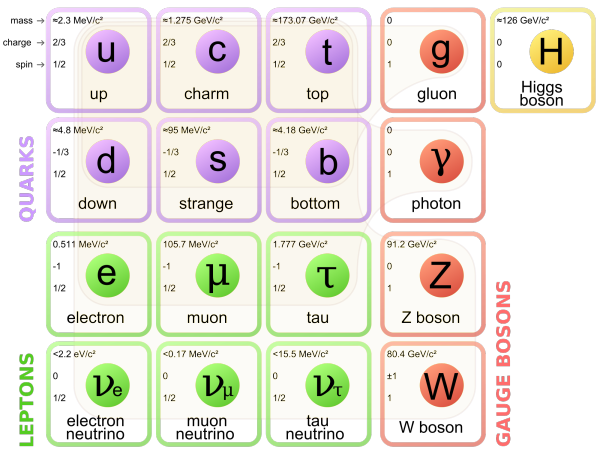
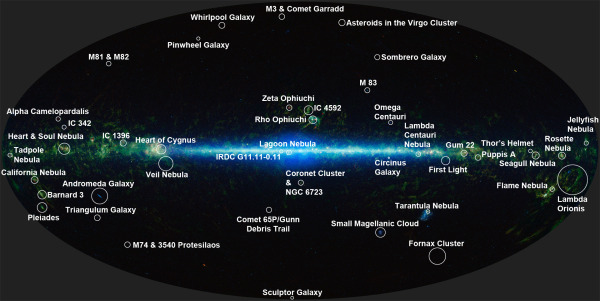
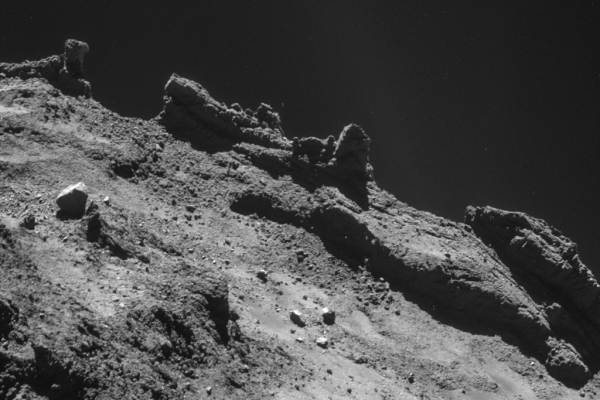


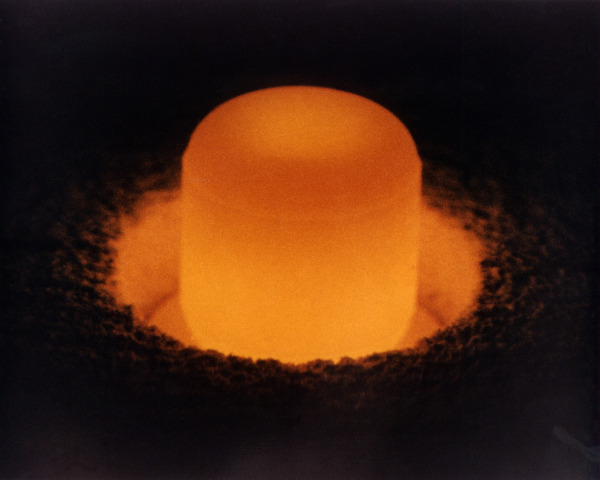
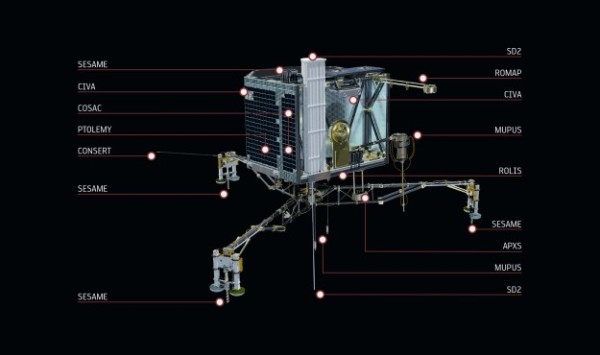
"But by and large, if you’re a spiral, the best you can hope for is to remain a spiral, but major mergers can transform you into an elliptical. If you’re already an elliptical, there’s no going back!"
I am not so sure about that. The galactic bulge in the Milky Way predates the spiral arms, and is to all intents and purposes an elliptical galaxy in the center of our bigger galaxy. (The spiral arms are thought to be the result of subsequent mergers.) If our galaxy is a counterexample, the Copernican principle says it is unwise to bet this is uncommon. Many, many, spirals have bulges (or bars) at their center, and I suspect they may all have the same evolutionary history.
Oh, and on ground-IR - ALMA does much of its magic in a transmission window in the Far-Far-IR at ~675 GHz (440 microns). Basically,. even at the high-altitudes of Mauna Kea or the Altacima Desert, this window is only available at the dryest of times. They actually have a microwave radiometer monitoring the water vapor so that they can drop everything and observe at the very high frequency bands when they are available. This site provides lots of details on this
https://almascience.nrao.edu/about-alma/weather
Haven't seen any major protests on the pollution of the jungle around Kourou so I don't think public opinion is a major factor for ESA. When you're cooperating between countries I imagine it's harder for everyone to get on board and break the rules, compared to when you run it yourselves.
It's political in nature, but completely understandable.
1. Without the cooperation of the member states, the project doesn't get done.
2. To gain the cooperation of the member states, project work must be handed out to those member states.
And no, we Americans are not immune from such insanity. For us, the exact same thing occurs on the state and district level, and we call it "pork barrel spending." To gain the vote of congresscritter X, you need to throw his/her district a bone. So you make sure his/her district benefits from the bill, even if that is an inefficient method of accomplishing the task, because if you don't do it, the task doesn't get accomplished at all.
After all, do you really think that all of NASA's test and launch facilities are where they are because those places were the most rational places to build them? No, they are where they are because we go through the same political wrangling that the Europeans do. How much sense does it make to have a solar-only deep space probe? About as much sense as building your big-project mission launch facility in FL while building your mission control site in TX.
eric, the device isn't an Off The Shelf item you can get at B&Q either.
Getting it from the Americans would not only have reduced payload but would likely have had to have some payment in quid-pro-quo with some US instrumentation taking the place of yet more EU science projects.
Add that there was no possible foresight to see all that went wrong going wrong and that the ONLY perspective that makes the nuclear option useful is one AFTER it's gone 60% titsup, and you have a completely sane rejection of the nuclear option.
Imagine if North Korea had wanted a probe (or, lets say more believably, China), would the USA have sold them one?
NO!!!!!!!
Well, if Russia sold them one, would that be accepted by the USA (and therefore by extension, the UK)?
HELL NO!!!!!
Heck, if we'd considered that the lander could end up in a dark hole, we could've arranged for Rosetta to, I dunno, carry a laser to zap some power to the lander. Or orient its solar panels to reflect a beam of sunlight down to the lander.
Admittedly a moving source and a moving target and a difficult way to deliver power through space, but hey, didn't Star Wars solve that problem already?
Oh, it didn't?
Nevermind.
Wow:
Of course not. But the ESA is not North Korea. That's a completely specious comparison. IMO the US would have no problem with ESA buying an RTG from Russia (assuming they would sell on, which they probably would...but at a significant markup over cost to produce), because as far as we're concerned that's transferring it from a moderately safe country to a much safer international organization.
I know, eric. It was an illustration made starkly apparent by extrapolation to the obvious.
The USA don't like France or Germany at the moment, and there are political problems with just selling plutonium. It's starkly obvious that NK won't get it EVEN IF THEY ABSOLUTELY INTEND TO SEND IT ON A PROBE.
It would not be allowed,even if there were hard guarantees and oversight.
The argument is only specious because you do not wish ESA to have an acceptable reason for not using an RTG.
This is not my problem, nor my care.
Ethan, and the commenters here, may be interested in the following news article from Nature: http://www.nature.com/news/nuclear-power-desperately-seeking-plutonium-…
The primary reason that Pu-238 isn't used on all deep space missions is because it isn't available. It was produced as a byproduct of breeder reactors, and purified as part of the reprocessing of so-called "spent" nuclear fuel in order to extract weapons-grade materials. That production has essentially stopped everywhere in the U.S. and Europe, and so the supply of Pu-238 is finite and dwindling.
Despite Ethan's idealism, restarting production of weapons-grade material "for scientific purposes" is not a realistic goal. Nor is it a statable goal which would be viewed realistically by anyone with any knowledge of the politics of the past seventy years.
Wow @8:
What does that have to do with anything? Rosetta and Philae were designed in the late '90s, completed before 2004, and launched in 2004. Mid to late '90s was the time when the US, Europe, and former Soviet Union were basically at maximum cooperation on nuclear nonproliferation issues. We and the Europeans helped the Russians secure their nukes. Heck, we worked with the Europeans and FSUs to change country ownership of actual nuclear weapons, shifting many of them out of FSU satellites back to Russia.
I will defer to Michael on the availability issue, but I think you are really way off track to think that the US would have any political issue with Europe using RTGs on their spacecraft. And you are waaaaay off track if you think Rosetta and Philae's technical capabilities owe anything at all to today's international political disputes.
Uh, *EVERYTHING*, eric.
Sorry, if you're too blind with trying to get your personal feeling of what "ought to be happening" to think outside your preconceptions, please ignore anything anyone else says on the subject, since you will automatically delete any contrary information, and your attempts to engage are therefore false and a waste of everyone's time.
@Wow #11: It rather appears that you're engaging in precisely the behaviour you are decrying in others. You are also engaging, whether deliberately or subconsciously, in a Whiggish revision of history.
Eric's point, which is quite right, is that the political climate _today_ cannot possibly have had any effect on decisions which were made twenty years ago. To assume so is naive at best, and deceitfully revisionist at worst.
If you want to assume a political reason for the design decisions of Rosetta/Philae, that is certainly a plausible thesis. However, if you are going to be intellectually honest about it, then you _must_ formulate that thesis in the conext of the political climate AT THE TIME the design decisions were made, not on the climate today.